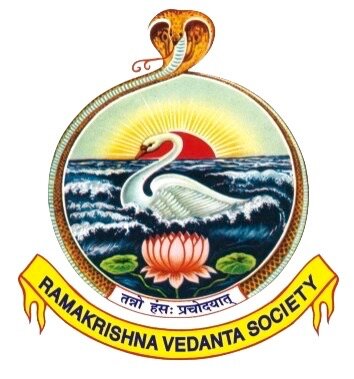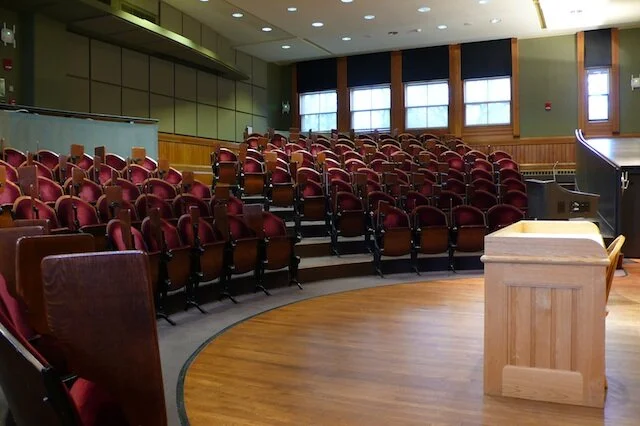Cambridge
Today's residents of Cambridge, Massachusetts, can be proud that a few of Swami Vivekananda's Cantabrigian contemporaries recognized his greatness. Professor J.H. Wright of Harvard supplied him with a letter of recommendation for the Parliament of Religions, his springboard to prominence in America. Mrs. Sara Bull, one of his American mothers, lived in Cambridge. Her organizational skills and lifelong support of the Vedanta movement enriched it greatly. And it was here that Swami Vivekananda won the admiration of Harvard philosophers including Professor William James.
By American standards, Cambridge has a long history: the first settlers reached New Towne from Boston in 1631, and after a few years renamed their locality after the University of Cambridge, England, in remembrance of their Puritan connections. Harvard College was founded here in 1636 to train ministers. It was named after donor (not founder) John Harvard, who donated his scholarly library. In the nineteenth century, transportation improvements led to a population boom in Cambridge in parallel with the growth of industries such as brick making and ice cutting in the northwestern part of the city. Radcliffe College was founded near Harvard in 1879, and MIT moved from Boston to Cambridge in 1916.
Harvard Yard
The central and earliest part of Harvard's campus is Harvard Yard. The “presiding deity” of the Yard is John Harvard himself, seated majestically in front of University Hall. Tourists are often seen taking selfies touching his left foot.
Sever Hall
May 16, 1894
In the Yard, turn to the north and walk around University Hall toward the east. When you see steps to your left, and distant steps to the right, you are in “Tercentenary Theater” where commencement ceremonies are held. Directly in front of you is Sever Hall, designed in the 1870's by H.H. Richardson, also the architect of Trinity Episcopal Church in Boston. If you arrive at a suitable time, walk up the same sandstone steps that Swami Vivekananda used, turn left in the lobby and peak into room 113. The original room number was 11.
Swami Vivekananda spoke here on Wednesday 16 May 1894 to the students of the Harvard Religious Union. His talk was reported briefly in the Harvard Crimson (vol. XXV, no 74, Thursday, May 17, 1894): “Swami Vivekananda, the Hindoo monk, gave an address last evening in Sever Hall under the auspices of the Harvard Religious Union. The address was very interesting, the clear and eloquent voice of the speaker, and his low, earnest delivery making his words singularly impressive.” The Crimson report then summarized the main points in Swamiji’s talk. The full text of the report can be found in Swamiji’s Complete Works, 2. 491-92.
Holworthy Hall
Retrace your footsteps at their heels until you pass University Hall again and turn toward the north. Look for Holworthy Hall just inside the northern gates of Harvard Yard. Professor Wright was living here in 1896, and Swami Vivekananda visited him in his room. During that visit, Prof. Wright took Swamiji to Harvard’s Faculty Club for lunch. Prof. Wright was a scholar of the ancient Greek and Latin, but he also knew Sanskrit.
LEHMAN Hall
March 25, 1896
The last stop in the Yard is in the southwest corner where Dane Hall housed the Psychological Laboratory. This was the venue of Swami Vivekananda's address to the Graduate Philosophical Society on 25 March 1896. Look for Lehman Hall, and imagine a smaller wooden building occupying about the western half of Lehman's footprint.
Dane Hall was constructed in 1832 as the first home of the Harvard Law School. When the law professors moved to Austin Hall, also designed by H. H. Richardson in 1881, Dane was occupied by the philosophy department. At that time there was no separation in academia between philosophy and psychology—a distinction was created later by the psychology experiments of Professor William James.
Which of the stars in Harvard’s galaxy of philosophers attended Swami Vivekananda’s lecture? We can surmise that since Professor James attended the Swami's earlier lectures in Boston, he would have been present for the Harvard address and likely invited colleagues. Swami Vivekananda’s talk was titled “The Vedanta Philosophy” and its text can be found in his Complete Works, 1. 357-65.
Prof. William James’s House (95 Irving St)
March 29, 1896
(2012)
On March 29th, Professor James invited Swami Vivekananda to his house for lunch. Prof. James lived with his family at 95 Irving Street, a short walk to the northeast. Follow Kirkland St. east from the Science Center and turn left on Irving Street.
Professor James deputized his teenage son as a messenger to accompany the Swami from his lodgings at Mrs. Bull's house. The younger William left this precious memory of meeting the Swami:
“I was deputed one spring Sunday morning (when I was about 13 years old) to call for [the Swami] at Mrs. Ole Bull’s house on Brattle St. and conduct him to lunch with my parents in Irving St. He of course was dressed in his turban and Hindoo robes and I remember feeling anxiety lest we should meet any of my schoolmates on our way across the Common. You can see that this fear of being conspicuous didn’t make for conversation – he being occupied with his high thoughts and I with my low ones. I remember that at lunch he and my father were much interested in each other – and that he accepted, in his stride, our American fare – in regard to which he must have had some dispensation.”
Mrs. Bull's House (168 Brattle St)
October 2–11, 1894
(2012)
The last and perhaps most poignant destination for the pilgrim in Cambridge is Mrs. Bull's house (which is now a private residence). Mrs. Sara Bull was one of Swamiji’s strongest American supporters. She offered her hospitality to him so that he could have time and space to write. There was a smaller house on the property called the Studio House. It was probably there that Swamiji stayed from October 2 to 11, 1894, and did his writing. The Studio House no longer exists. Swamiji returned to Mrs. Bull’s house in December that year.
December 1894
The inaugural meetings of Mrs. Bull’s Cambridge Conferences were held in December 1894 at the nearby home (181 Brattle St, which is now 12 Lakeview Ave) of a Mrs. Richards. Swamiji delivered talks on “The Vedanta Philosophy” (December 10) and “The Rajpoot Women and Ideals of Motherhood in India” (December 17). In addition to formal lectures, he gave many class talks between December 5 and 27.
In later years, Mrs. Bull hosted Swamiji’s brother monks Swamis Saradananda and Abhedananda as well as Western Vedanta followers such as Swami Kripananda (Leon Landsberg), Sister Nivedita (Margaret Noble), Sister Christine (Christina Greenstidel), and J. J. Goodwin (Swamiji’s stenographer, who transcriptions form a bulk of Swamiji’s Complete Works).
Prof. Wright’s House (6 Riedesel Ave)
May 6–7, 1894
A few blocks back east on Brattle St. is Riedesel Ave. Cross Brattle St and turn left on Riedesel and look for #6 just before reaching Brewster Street. Swami Vivekananda slept here on Prof. Wright's couch on the night of 6 – 7 May 1894. He transferred to the Hotel Bellevue in Boston the following day to avoid imposing on the family.
Sources
Marie Louise Burke, Swami Vivekananda in the West: New Discoveries
Asim Chaudhuri, Swami Vivekananda in America, New Findings
Pravrajika Prabuddhaprana, Saint Sara: The Life of Sara Chapman Bull, the American Mother of Swami Vivekananda
Research by Joseph Peidle













